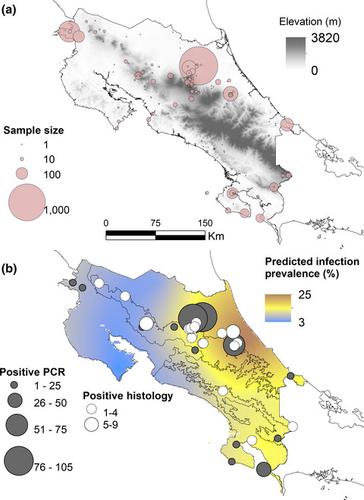当前位置:
X-MOL 学术
›
Biotropica
›
论文详情
Our official English website, www.x-mol.net, welcomes your
feedback! (Note: you will need to create a separate account there.)
Species distribution models predict the geographic expansion of an enzootic amphibian pathogen
Biotropica ( IF 1.8 ) Pub Date : 2020-10-06 , DOI: 10.1111/btp.12863 Héctor Zumbado‐Ulate 1 , Adrián García‐Rodríguez 2, 3 , Catherine L. Searle 1
Biotropica ( IF 1.8 ) Pub Date : 2020-10-06 , DOI: 10.1111/btp.12863 Héctor Zumbado‐Ulate 1 , Adrián García‐Rodríguez 2, 3 , Catherine L. Searle 1
Affiliation

|
Globally, numerous amphibian species have declined due to the introduction of the chytrid fungus Batrachochytrium dendrobatidis (Bd). However, the understanding of the spatiotemporal dynamics remains incomplete. Therefore, estimating the current geographic distribution of Bd is urgently needed, especially in countries like Costa Rica, where susceptible species are still recovering from Bd‐driven declines. We conducted model tuning and spatial analysis to compare the habitat suitability for epizootic and enzootic Bd in Costa Rica and to identify data‐deficient regions, opportunistic sampling, and Bd hotspots. Our dataset combined two methods of detection (histology and PCR methods) for a total of 451 Bd‐positive records from 34 localities. We found that the distribution of enzootic Bd in Costa Rica increased 60% since previous estimates in the early 2000s and extended to highlands and dry lowlands that were considered unsuitable for Bd. We also found that Bd is common across protected lands (80%) and within the herpetological provinces containing the highest amphibian richness and endemism in Costa Rica. Opportunistic sampling of Bd has focused on sites where epizootics occurred with the strongest intensity, leading to deficient or absent sampling across the Talamanca Range, the Nicoya Peninsula, and the northern lowlands. Our results showed that PCR increased the power of Bd detection in lowlands and favored the identification of Bd hotspots across the Caribbean side of Costa Rica. Our results add to the understanding of disease spread during enzootics and can be used to identify new hotspots for disease to mitigate future outbreaks of this pathogen.
中文翻译:

物种分布模型预测了两栖动物的致病性地理分布
在全球范围内,由于引入了chychyd真菌Batrachochytrium dendrobatidis(Bd),导致了许多两栖动物物种的减少。但是,对时空动力学的理解仍然不完整。因此,迫切需要估算当前Bd的地理分布,尤其是在哥斯达黎加等国家,那里的易感物种仍从Bd驱动的下降中恢复过来。我们进行了模型调整和空间分析,以比较哥斯达黎加流行性和流行性Bd的栖息地适宜性,并确定数据不足的区域,机会性抽样和Bd热点。我们的数据集结合了两种检测方法(组织学和PCR方法),共来自34个地区的451个Bd阳性记录。我们发现,自2000年代初以来,哥斯达黎加的共生Bd分布比先前的估计增加了60%,并扩展到了认为不适合Bd的高地和干旱低地。我们还发现,Bd在受保护的土地(80%)以及在哥斯达黎加两栖动物丰富度和地方性最高的爬虫类省份中很常见。Bd的机会抽样重点研究了动物传染病发生强度最高的地点,导致整个塔拉曼卡山脉,尼科亚半岛和北部低地的采样不足或缺乏。我们的结果表明,PCR可提高低地中Bd的检测能力,并有助于在哥斯达黎加加勒比海一侧确定Bd热点。我们的研究结果加深了对动物传播期间疾病传播的理解,可用于识别疾病的新热点,以减轻这种病原体的未来爆发。
更新日期:2020-10-06
中文翻译:

物种分布模型预测了两栖动物的致病性地理分布
在全球范围内,由于引入了chychyd真菌Batrachochytrium dendrobatidis(Bd),导致了许多两栖动物物种的减少。但是,对时空动力学的理解仍然不完整。因此,迫切需要估算当前Bd的地理分布,尤其是在哥斯达黎加等国家,那里的易感物种仍从Bd驱动的下降中恢复过来。我们进行了模型调整和空间分析,以比较哥斯达黎加流行性和流行性Bd的栖息地适宜性,并确定数据不足的区域,机会性抽样和Bd热点。我们的数据集结合了两种检测方法(组织学和PCR方法),共来自34个地区的451个Bd阳性记录。我们发现,自2000年代初以来,哥斯达黎加的共生Bd分布比先前的估计增加了60%,并扩展到了认为不适合Bd的高地和干旱低地。我们还发现,Bd在受保护的土地(80%)以及在哥斯达黎加两栖动物丰富度和地方性最高的爬虫类省份中很常见。Bd的机会抽样重点研究了动物传染病发生强度最高的地点,导致整个塔拉曼卡山脉,尼科亚半岛和北部低地的采样不足或缺乏。我们的结果表明,PCR可提高低地中Bd的检测能力,并有助于在哥斯达黎加加勒比海一侧确定Bd热点。我们的研究结果加深了对动物传播期间疾病传播的理解,可用于识别疾病的新热点,以减轻这种病原体的未来爆发。











































 京公网安备 11010802027423号
京公网安备 11010802027423号